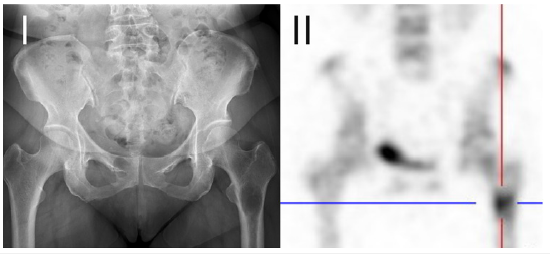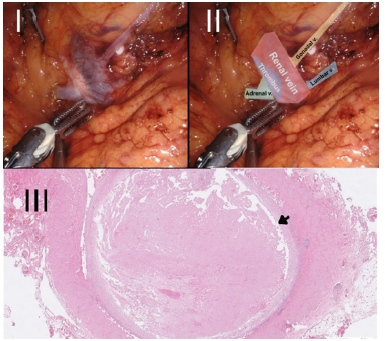- Submissions

Full Text
Novel Approaches in Cancer Study
Could Neoadjuvant Cabozantinib plus Nivolumab followed by Cytoreductive Nephrectomy be the Future Treatment Strategy for Advanced Renal Cell Carcinoma?
Chen Hung Hsu1,2, Ching Che Chou1,2 and Hung Yi Chen1,2*
1Divisions of Urology, Department of Surgery, Keelung Chang Gung Memorial Hospital, Taiwan
1College of Medicine2, Chang Gung University, Taoyuan, Taiwan
*Corresponding author:Hung Yi Chen, MD, Divisions of Urology, Department of Surgery, Keelung Chang Gung Memorial Hospital, No. 222, Maijin Rd., Anle Dist., Keelung City 204201, Taiwan
Submission: January 23, 2023 Published: February 16, 2023

ISSN:2637-773XVolume7 Issue 4
Abstract
Over time, works from oncologists and scientists have contributed to the development of systemic therapies for metastatic renal cell carcinoma (mRCC) with contemporary studies showing superior disease free and overall survival benefits in mRCC patients treated with tyrosine kinase inhibitors (TKI) combined with immune checkpoint inhibitors (ICI). The role of cytoreductive nephrectomy is however still controversial. Here we present with a 57-year-old female patient who suffered from mRCC with left renal vein tumor thrombus, left adrenal, right upper lobe lung and left hip metastases. After 6 months of combination systemic therapy with cabozantinib plus nivolumab, the patient achieved a partial response and received robot assisted laparoscopic cytoreductive nephrectomy (CN). Pathology report of the primary tumor in the left kidney was 85% necrotic and the resected specimens involving the left renal vein thrombus and left adrenal revealed exclusively necrotic tissues. Three months postoperative, an image study showed no evidence of recurrence. Radical nephrectomy after neoadjuvant cabozantinib plus nivolumab in selected patients may achieve disease free status.
Keywords:Renal cell carcinoma; Immunotherapy; Nephrectomy; Cytoreduction surgical procedure
Keywords:mRCC: Metastatic Renal Cell Carcinoma; TKI: Tyrosine Kinase Inhibitor; ICI: Immune Checkpoint Inhibitor; CN: Cytoreductive Nephrectomy; CT: Computed Tomography; ORIF: Open Reduction and Internal Fixation; IMDC: Metastatic RCC Database Consortium, SWOG: Southwest Oncology Group, EORTC: European Organization for the Research and Treatment of Cancer, EAU: European Association of Urology
Introduction
Globally, there are over 430,000 new cases of renal cell carcinoma (RCC) and over 179,000 deaths annually due to kidney cancer [1]. The survival rate of patients with RCC highly depends on cancer staging and the 5-year survival of cases with distant metastases is around 12% [2]. Over time, works from oncologists and scientists have contributed to the development of systemic therapies for metastatic renal cell carcinoma (mRCC). Prior to the year 2005, treatment of mRCC involved predominantly interferon-alpha and uses of high dose interleukin 2. With more understanding of the molecular biology, multiple receptor TKI then became the mainstream treatment and had shown drastic improvements in survival rate. After 2015, ICI, like nivolumab, has become another option for mRCC systemic therapies [3]. Several phase 3 trials focus on the survival rate and adverse effects of combination therapy with TKI and ICI [4-8].
Regarding the role of surgery in the TKI era, the CARMENA trial [9] showed mRCC patients treated with TKI alone was not inferior to those treated with CN followed by TKI. However, in the era of combination therapy, the role of cytoreductive nephrectomy is yet unclear. In this article, we present a case of mRCC who received combined systemic therapy with cabozantinib and nivolumab followed by CN and has remained disease free.
Case Presentation
We present a 57-year-old female patient with underlying hypertension who suffered from left hip pain since February 2022. She visited the orthopedic outpatient department in April 2022 where a pelvic plain film and a bone scan showed an osteolytic lesion over the left proximal femur (Figure 1). Considering the possibility of a metastatic lesion, abdominal computed tomography (CT) scan was arranged and unveiled a 8.9cm left renal upper pole mass with tumor extension to left renal vein (Figure 2 I) and metastasis over left adrenal gland and right upper lobe lung, initial clinical staging cT3aN0M1. In May 2022, prophylactic left femoral neck open reduction and internal fixation was performed due to claudication and impending pathological fracture with resulting pathology showing metastatic clear cell RCC (mccRCC). CT-guided renal mass biopsy confirmed clear cell RCC pathology. Laboratory tests were compatible with the poor risk group according to the International Metastatic renal cell carcinoma Database Consortium (IMDC). We thus prescribed systemic therapy with cabozantinib 40mg daily and nivolumab 200mg every 2 weeks according to Check Mate 9ER trial. After 6 months of combination therapy, interval abdominal CT and Magnetic Resonance Imaging (MRI) images showed regression of the lung and adrenal gland metastasis and shrinkage of the left renal vein thrombus from 2.5cm to 2.0cm (Figure 2). The left upper pole renal mass also showed interval necrotic changes. To reduce tumor burden, left robot assisted laparoscopic cytoreductive nephrectomy, adrenalectomy and left renal vein thrombectomy were performed in November 2022 and intraoperative image showed macroscopic tumor thrombus in the left renal vein (Figure 3 I&II). Pathological report of the resected adrenal gland and renal vein tumor thrombus revealed only necrotic tissues without malignant cells (Figure 3 III). Up to 85% necrosis of the left upper pole tumor was also noted. Postoperative recovery was smooth without complication and the patient was discharged on postoperative day 4. We restarted systemic cabozantinib plus nivolumab 1 month after surgery. Three months postoperative, an image study showed no evidence of recurrence.
Figure 1:Osteolytic lesion in left proximal femur on X-ray (I) and bone scan (II).

Figure 2: CT images of left renal mass and left renal vein tumor thrombus in pre-systemic therapy (I), 3 months after combined systemic therapy (II). MRI image 6 months after combined systemic therapy (III).

Figure 3: Intraoperative view of left renal vein tumor thrombus (I) and (II). Necrotic tissues encircled by vascular endothelium. No malignant cells were noted (III).

Discussion
In the cytokine era, combined analysis of Southwest Oncology Group (SWOG) 8949 and European Organization for the Research and Treatment of Cancer (EORTC) 30947 revealed a median survival of 13.6 months for CN plus interferon versus 7.8 months for interferon alone which suggest significant improvement in the overall survival in mRCC patients treated with interferon plus CN [10].
During the TKI era, CARMENA trial revealed non-inferiority for mRCC patients treated with TKI alone compared with those that received CN followed by TKI. These results contributed to several randomized clinical trials, namely CheckMate 214, KEYNOTE 426, Check Mate 9ER and JAVELIN Renal 101 and KEYNOTE-581 [4- 8], of combination therapy with TKI plus ICI or ICI plus ICI, which have become the mainstream first line treatment. In the network meta-analysis study for the first-line treatment of mRCC by Riaz et al. [11]. Cabozantinib plus nivolumab combination is the most effective in terms of overall response rate, progression-free survival and overall survival. However, the role of CN in the era of combined therapy is still controversial. Two ongoing trials NORDIC-SUN and PROBE both compare survival rates between combination therapy and combination therapy with CN [12] to look for how CN in combination therapy can achieve the best oncological outcome. As we await the results of the two ongoing aforementioned trials, we propose this case report about mRCC on the plausibility of receiving combination regimen to minimize tumor burden first, followed by minimal invasive CN which may show favorable pathological outcome and even reach disease free status.
Conclusion
Contemporary studies have yet to prove the oncological outcome of CN in mRCC patients treated with combination therapy. The outcome of this case report suggested that combined neoadjuvant cabozantinib plus nivolumab followed by CN may be a feasible treatment strategy for advanced mRCC in the future.
References
- Padala SA, Barsouk A, Thandra KC, Saginala K, Mohammed A, et al. (2020) Epidemiology of renal cell carcinoma. World Journal of Oncology 11(3): 79-87.
- Siegel RL, Miller KD, Jemal A (2017) Cancer statistics, 2017. CA: A Cancer Journal for Clinicians 67(1): 7-30.
- Hsieh JJ, Purdue MP, Signoretti S, Swanton C, Albiges L, et al. (2017) Renal cell carcinoma. Nature Reviews Disease Primers 3: 17009.
- Cella D, Grünwald V, Escudier B, Hammers HJ, George S, et al. (2019) Patient-reported outcomes of patients with advanced renal cell carcinoma treated with nivolumab plus ipilimumab versus sunitinib (CheckMate 214): a randomised, phase 3 trial. The Lancet Oncology 20(2): 297-310.
- Powles T, Plimack ER, Soulières D, Waddell T, Stus V, et al. (2020) Pembrolizumab plus axitinib versus sunitinib monotherapy as first-line treatment of advanced renal cell carcinoma (KEYNOTE-426): extended follow-up from a randomised, open-label, phase 3 trial. The Lancet Oncology 21(12): 1563-1573.
- Motzer RJ, Choueiri TK, Powles T, Burotto M, Bourlon MT, et al. (2021) Nivolumab+ cabozantinib (NIVO+ CABO) versus sunitinib (SUN) for advanced renal cell carcinoma (aRCC): Outcomes by sarcomatoid histology and updated trial results with extended follow-up of CheckMate 9ER. American Society of Clinical Oncology.
- Choueiri TK, Motzer RJ, Rini BI, Haanen J, Campbell MT, et al. (2020) Updated efficacy results from the JAVELIN Renal 101 trial: first-line avelumab plus axitinib versus sunitinib in patients with advanced renal cell carcinoma. Annals of Oncology 31(8):1030-1039.
- Motzer R, Alekseev B, Rha SY, Porta C, Eto M, et al. (2021) Lenvatinib plus Pembrolizumab or Everolimus for advanced renal cell carcinoma. New England Journal of Medicine 384(14): 1289-1300.
- Mejean A, Thezenas S, Chevreau C, Bensalah K, Geoffrois L, et al. (2019) Cytoreductive nephrectomy (CN) in metastatic renal cancer (mRCC): Update on Carmena trial with focus on intermediate IMDC-risk population. American Society of Clinical Oncology 37(15): 4508-4508.
- Flanigan RC, Mickisch G, Sylvester R, Tangen C, Van Poppel H, et al. (2004) Cytoreductive nephrectomy in patients with metastatic renal cancer: a combined analysis. The Journal of Urology 171(3): 1071-1076.
- Riaz IB, He H, Ryu AJ, Siddiqi R, Naqvi SAA, et al. (2021) A living, interactive systematic review and network meta-analysis of first-line treatment of metastatic renal cell carcinoma. European Urology 80(6): 712-723.
- Meza L, Chawla NS, Giannarini G, Pal SK (2022) Cytoreductive nephrectomy in 2021: Obsolete. European Urology Open Science 36: 44-46.
© 2023. Hung Yi Chen. This is an open access article distributed under the terms of the Creative Commons Attribution License , which permits unrestricted use, distribution, and build upon your work non-commercially.
 a Creative Commons Attribution 4.0 International License. Based on a work at www.crimsonpublishers.com.
Best viewed in
a Creative Commons Attribution 4.0 International License. Based on a work at www.crimsonpublishers.com.
Best viewed in 







.jpg)






























 Editorial Board Registrations
Editorial Board Registrations Submit your Article
Submit your Article Refer a Friend
Refer a Friend Advertise With Us
Advertise With Us
.jpg)






.jpg)














.bmp)
.jpg)
.png)
.jpg)










.jpg)






.png)

.png)



.png)






